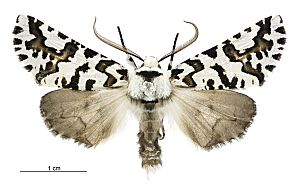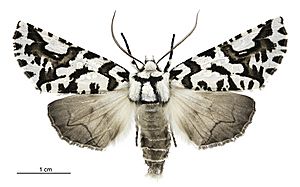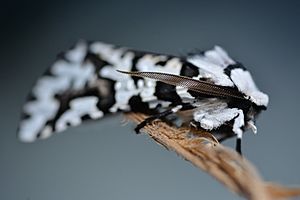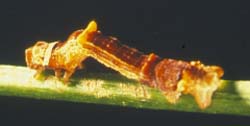North Island lichen moth facts for kids
Quick facts for kids North Island lichen moth |
|
|---|---|
 |
|
| Male specimen | |
 |
|
| Female specimen | |
| Scientific classification | |
| Kingdom: | |
| Phylum: | |
| Class: | |
| Order: | |
| Family: | |
| Genus: | |
| Species: |
D. atronivea
|
| Binomial name | |
| Declana atronivea (Walker, 1858)
|
|
| Synonyms | |
|
|
The Declana atronivea, also known as the North Island lichen moth or North Island zebra moth, is a type of moth. It belongs to the family Geometridae. This moth is special because it is only found in New Zealand. It is also one of only two insect species in the world that has wings with patterns that are not the same on both sides. This means its wing markings are asymmetrical!
Contents
About the North Island Lichen Moth
The Declana atronivea moth was first described by a scientist named Frances Walker in 1865. He first called it Detunda atronivea.
What the Moth Looks Like
The young moths, called larvae or caterpillars, look quite lumpy. They are usually brown and brownish-white. They can grow to be about 30 millimeters long. When they are very young, they curl up on a leaf. This makes them look like a bird dropping, which helps them hide from predators!
Adult D. atronivea moths have a wingspan of about 40 to 45 millimeters. Their wings are mostly white with dark brown or black markings. This moth looks a lot like its close relative, the South Island lichen moth (Declana egregia). However, the North Island lichen moth has fewer dark spots. It also does not have dark edges on its front wings. This gives it a more "mottled" or patchy look. It also has a black rectangle mark on its back, near its head.
A scientist named Hudson noticed something very interesting about these moths. He saw that the black markings on their front wings can be different sizes and shapes. Sometimes, the markings are even slightly different on the left and right wings of the same moth! This moth is famous for its asymmetrical wing patterns. Out of 180,000 types of moths and butterflies, it is the only one with wings that are not mirror images of each other. In fact, it is one of only two insect species known to have this kind of uneven wing pattern. The other is a mantis called Tithrone roseipennis.
Where the Moth Lives
The D. atronivea moth is found only in the North Island of New Zealand. In 1913, it was thought to be rare around the Whanganui area. But it was very common near Mount Taranaki and Mount Ruapehu. These moths have also been seen in places like Wellington, Otaki, and Napier.
Life Cycle of the Moth
The life of the D. atronivea moth begins when eggs are laid. This usually happens around the end of October. The eggs are oval-shaped and have a slightly rough surface. They start out green. After about a week, they turn a light blue color with purple spots. Just before they hatch, they become a light purple. The female moth lays her eggs one by one. The eggs hatch after about 11 days.
The caterpillars (larvae) are usually brownish or blackish-green. However, their exact color can change a lot. When the caterpillars are ready, they form a light-colored cocoon. They make this cocoon among leaves on the ground. The adult moths then come out of their cocoons in February and March. Some moths spend the winter as pupae (inside their cocoons) and then turn into adults later.
Host Plants for Caterpillars
The caterpillars of the D. atronivea moth feed on certain plants. These plants are called host plants. They include different types of Pseudopanax trees. Two examples are Pseudopanax arboreus and Pseudopanax crassifolium.



